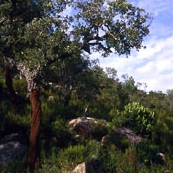
BIGGEST CORK TREE PLANTATION C&L WILL PRODUCE 200,000 KILOS OF CORK THIS YEARBiggest cork tree plantation in C&L will produce 200,000 kilos of cork this yearThe biggest cork tree plantation in Castilla y León, in Valdelosa near Salamanca, will this year produce around 150,000 kilos of cork strip, used for stoppers, and another 50,000 of what is known in the trade as “first stripping”, used for decoration. The mountain of Valdelosa has a surface-area of 6,000 hectares and is the “only pure cork tree in the region, there are similar trees only in Portugal and Extremadura”, the mayor of the town Manuel Prada (PP) told Efe. The task of gathering the cork began a few days ago and will go on to the end of this month of August, being carried out by a team of twenty-two people – eleven pairs – from Extremadura, which is “where the few experts who remain to carry out these tasks come from”, Prada explained. “It is a job”, the mayor continued, “which may well disappear, as it is very hard to find people who really know how to do it”. The present campaign is going “very well” and the Town Council, according to the mayor, hopes to make around 300,000 euros, although cork “is suffering the consequences of the standstill the wine business is going through”. It should be borne in mind that big reserves use stoppers “which can cost up to 0•6 euros as against those used in ordinary wines which are worth 0•03 euros”, the mayor pointed out. The working day of the “corkers” begins at seven in the morning, when they prepare to go out into the fields and share the work out by pairs. Each group decorks some twenty hundred-weight of material a day, which means an average of forty trees, although this depends on their thickness. The workers are guided by a “handler”, and when the work on each cork tree is finished they leave the shed cork at the side of the tree, for the collectors to pile it up to be transported. The teams of collectors are made up of residents of Valdelosa, who see in this work “an opportunity to make some money during the summer”, according to the mayor. From among the thousands of trees in the fields of Valdelosa two stand out which are more than 250 years old, known to the locals as “cart-loads” because a cart-load of cork is taken from each one and they have a thickness similar to that of five people with their hands joined in a ring. A cork tree starts to be productive after fifty years and can give up to twenty harvests with an interval in between of 10 or 11 years, “which is shortened in Extremadura to 8 or 9 years because here the climate makes growth slower”, said Prada. |
| Cork specialists - Cork treatment - Cork-2000 | website map |
CA ES
ES EN
EN FR
FR
|
 |
 |
 |
 |
 |

